PROBABILITIES INVOLVING "OR," "NOT" and CONDITIONAL PROBABILITY
Probabilities involving "or", "not"
In general:
P(E or F) = P(E) + P(F) - P(E and F)
P(not E) = 1 - P(E)
(Note: these problems can frequently be analyzed with Venn diagrams as well.)
EXAMPLE 3.4.1
According to a recent article from the New England Journal of Medical Stuff ,
63% of cowboys suffer from saddle sores,
52% of cowboys suffer from bowed legs,
and 40% suffer from both saddle sores and bowed legs.
What is the probability that a randomly selected cowboy...
1. ...has saddle sores or bowed legs?
2. ...doesn't have saddle sores?
3. ...has saddle sores but doesn't have bowed legs?
4. ...has saddle sores and bowed legs?
5. ...has neither of these afflictions?
see solutions
EXAMPLE 3.4.2
A survey of 50 Yugo drivers revealed the following:
30 enjoy waiting for tow trucks
35 enjoy hitchhiking
25 enjoy waiting for tow trucks and hitchhiking
What is the probability that a randomly selected Yugo driver...
1. ...enjoys at least one of these activities?
A. .8
B. .65
C. .9
D. 1.8
2. ...doesn't enjoy hitchhiking?
A. .35
B. .15
C. .3
D. .5
3. ...enjoys neither of these activities?
EXAMPLE 3.4.3
The table below shows the distribution of guests on the Jerry Slinger show.
S: screams obscenities P: punches somebody

1. What is the probability that a guest screams obscenities or punches somebody?
2. What is the probability that a guest doesn't scream obscenities and doesn't punch anybody?
see solutions
MUTUALLY EXCLUSIVE EVENTS
Events E and F are mutually exclusive if it is not possible for both E and F to occur simultaneously.
This means that P(E and F) = 0.
If events E, F are mutually exclusive, then P(E or F) = P(E) + P(F)
EXAMPLE 3.4.4
In a certain class, 45% of the students are freshmen (F), 30% are sophomores (So)
20% are juniors (J), 5% are seniors (Se)
What is the probability that a randomly chosen student is a junior or senior?
see solution
EXAMPLE 3.4.5
A university awards scholarships on the basis of student performance on a certain placement test. The table below indicates the distribution of scores on that test.
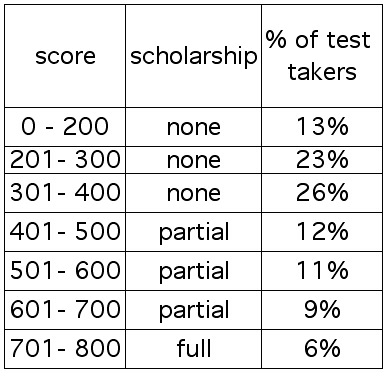
If one student is randomly selected, find the probability that he/she...
1. ...received a partial scholarship.
2. ...didn't have a score in the 201 - 300 range.
3. ...had a score less than 501
4. ...received some kind of scholarship
If 800 students are selected, how many would we expect...
5. ...received no scholarship?
6. ...had scores higher than 600?
EXAMPLE 3.4.6
The pie chart below shows the distribution of animals at Gomer's Petting Zoo.
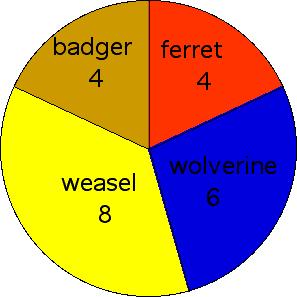
If one animal randomly goes on a rampage, find the probability that it is...
1. ...a weasel or badger?
2. ...not a badger or ferret?
Suppose we roll one die.
Let A be the event that the result is the number "2."
Then we know that
![]()
However, suppose that before I reveal the result of the die roll, I tell you that an
even number has occurred (event E).
Would you still say that
![]()
This is an example of CONDITIONAL probability.
We say that
"The probability that the die roll is '2,' given that the die roll is 'even,' is 1/3.
Notation:
![]()
or
![]()
General fact:
For any events E, F
![]()
which is the same as
![]()
If we are referring to population statistics,

EXAMPLE 3.5.7
In a box we have a bunch of puppies:
4 brown bulldogs
2 gray bulldogs
5 brown poodles
3 gray poodles
If one puppy is selected, what is the probability that the puppy is...
1. ...brown?
2. ...a poodle?
3. ...gray or a bulldog?
4. ...brown and a bulldog?
5. ...a bulldog, given that it is gray?
6. ...brown, given that it is a poodle?
see solutions
EXAMPLE 3.4.8
A survey of Gators indicates that 7% are charming, 4% are modest, and 3% are
both charming and modest. Find the probability that a Gator is modest, given
that he/she is charming.
A. .75
B. .03
C. .43
D. .25
see solution
EXAMPLE 3.4.9
Refer to this data on scholarships.
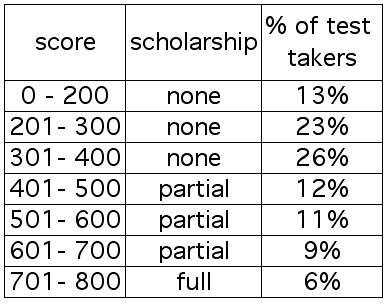
2. What is the probability that a randomly chosen student received a scholarship,
given that he/she had a score less than 501?
see solution
EXAMPLE 3.4.10
The table below shows the distribution according to cumulative GPA of
juniors at Normal University.
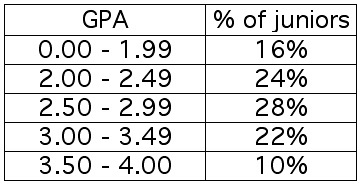
1. Find the probability that a randomly selected junior's GPA is greater than 1.99,
given that it is less than 3.50.
A. .22
B. .88
C. .82
D. .74
2. Referring to the data above, find the probability that a randomly selected
junior's GPA is in the 2.50 - 3.49 range, given that it is greater than 1.99.
EXAMPLE 3.4.11
Recently, Gomer took his Yugo to Honest Al's Yugo Repair Shop for a brake job.
Later, while driving home, a wheel fell off of the car.
When Gomer returned to Honest Al's to complain that the wheel must have fallen off
because of the brake job was done incorrectly, Honest Al produced a ream of statistics
from NHTSA that showed that for this type of brake job, the probability that the wheel
will fall off, even if the work is done incorrectly, is only about 0.008.
Based on that data, Honest Al graciously offered to cover 1% of the cost of repairing
the damage to Gomer's car.
What question should Gomer have asked?
C: work done correctly F: wheel fell off

EXAMPLE 3.4.12
Suppose that the data below comes from the FBI Uniform Crime Statistics.
It conveys information about the number of Americans (per 100,000 population)
involved in the crimes of toad theft and toad smoking.
Per 100,000 population: 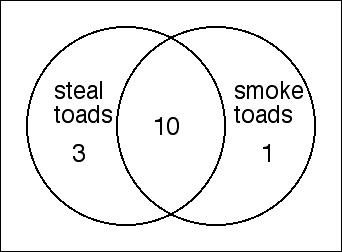
A rare, exotic toad has been stolen from the Tallahassee Museum.
Police are searching for Gomer, who is the only known toad-smoker in town.
Meanwhile, Gomer's lawyers have spoken out publicly. Referring to the data shown above,
they state that, since only 10 out 100,000 people are both toad-stealers and toad-smokers,
it is extremely unlikely that Gomer is the guilty party, and so the police
should focus their investigation elsewhere.
What do you think about this claim?
EXAMPLE 3.4.14
The conventional test for tuberuculosis (TB) is only about 50% accurate.
Does this mean that if you test positive for TB, then the probability that you
actually have TB is about .5? Suppose that the table below summarizes the results
of the TB screening for a sample of 500 people.
In this table, TB means "A person has tuberculosis," and P means "A person tests
positive for TB."

Use this information to find the probability that a person who tests positive for
TB actually has the disease.
see solution
Download practice exercises (PDF file)